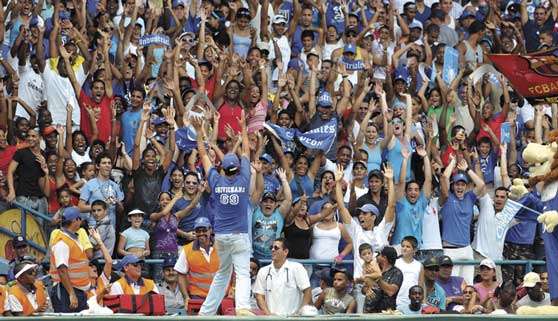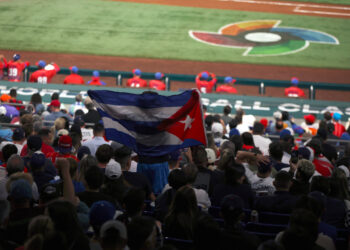Photos: Ricardo López Hevia
It is the Latinoamericano stadium on Sunday, January 19, 1986, and the 25th Cuban National Baseball Series is being decided. The Industriales have gone 15 years without winning the championship and the Vegueros are defending their crown. It is the bottom of the 12th inning in this never-ending game.
It’s 9:15. The scoreboard shows two outs, and Rogelio García is on fire. Javier Méndez gets a hit, but first Vargas and then Medina have struck out. The booming voice on the loudspeaker announces, “Number 40…Agustín Marquetti…first base,” and there he goes, walking slowly and dragging his bat, as if reluctant.
The “Latino” is overflowing and steam rises from the stands, a mixture of heat from the lights and energy given off by some 60,000 people exhausted with emotion. The Vegueros have been in the lead since the third inning, when the great Luis Giraldo Casanova and Lázaro Madero batted consecutive home runs against the Industriales’ iron-armed Lázaro de la Torre, who was relieved by Despaigne. They scored another hit, but hopes continued to be high for Pedro Chávez’s Industriales.
The spark was lit by Rolando Verde’s home run. We knocked two points off their lead, but in the next inning, the Vegueros’ Linares “The Kid” sent the ball soaring over centerfield, an awesome home run. With the “Blues” (Industriales) back at bat, their catcher Medina slams the ball against the fence, bringing in the third run and the game ties. Great fielding, things are heating up, and there’s a real pileup at home plate when Vargas slides hard and scores, giving us the lead. The Vegueros’ catcher, Juan Castro, makes an illegal move with his foot on Vargas’s chest, an argument follows and the public screams, enraged.
It’s almost the end. We’re in the ninth, and Industriales is winning 5 to 4. The band playing in the left wing of the grandstand is celebrating to a conga beat, and people are dancing and yelling. It’s the last chance for the Vegueros. A line drive down center field. If the man on second reaches home, it’ll tie the game. He makes it to third, but now there are two outs – one out away from victory. Some people bite their nails, others pray and everybody contemplates the end. A slow rolling hit between first and second, and Padilla can’t reach it. Faces pale, the music stops. The game is tied.
Twelfth inning. Man on first for the Industriales, and Rogelio continues to dominate – he’s just struck out two batters. The voice over the loudspeaker, thick and mysterious with the echo produced by its travel through the loudspeakers, announces, “Number 40…Agustín Marquetti…first base….” The Industriales’s fourth batter approaches, dragging his bat, calm as always. Rogelio pitches him a strike, and then two balls. It’s 9:20 p.m. The crowd claps as encouragement, but then it dies out after the second strike. The forkball that Rogelio throws does not finish dropping off the plate and finishes a little bit high. The moment that Marquetti begins to swing his bat an incredible, absolute silence falls…the dry “thwack!” sound when the wood hits the ball right in the center echoes like an explosion. The ball rises and bleachers roar; it takes barely a second to travel to the stands behind right-center — more than 345 feet high — but it seems like an eternity in slow motion. Rogelio doesn’t move. Marquetti places his hands on his head; he can’t believe that he has just hit the home run that is everybody’s dream. The ball hasn’t fallen yet and the crowd has flung itself onto the field. The batter touches first and keeps going and then something happens that will go down in Cuban baseball history as a lesson in ethics: the losing team’s shortstop, Giraldo González, standing next to second base, stretches out his hand: he is the first to congratulate him. Marquetti is barely able to touch second base and the field is a seething mass that prevents him from reaching home. I don’t know how I leapt; it was wild abandon and I was dragged along with my friends to the wall, which was much higher than I thought. I was running over the field, everybody was yelling and strangers were hugging – it was “blue craziness.”
For many Cubans, going to the Latino, or the “Colossus in Cerro,” means enjoying a special and often unforgettable day. It opened in 1946 and the first game was between Havana’s Almendares (which many believe to be the ancestor of Industriales) and Cienfuegos. Some 31,000 were reported to be in attendance, a record and without bleachers behind outfield. With the name of Gran Estadio de La Habana (Great Stadium of Havana), it was the setting for professional baseball and for the start of the National Series.
It is the official headquarters of the Industriales and the place where the strongest rivalries in the country are manifest. This cosmopolitan city is home to many Cubans from other provinces who always cheer for their home teams against the Industriales. Therefore, at the most anticipated games — especially when the Industriales are playing against one of the other great teams, such as Santiago de Cuba, Pinar del Río or Villa Clara — the stands are clearly divided, often equally. In the left wing of the bleachers, the home team’s fans are seated over the third-base dugout, while the visiting team’s admirers take up their positions behind the first-base dugout. This causes chants to go up alternatively from each side, depending on how the game goes.
There are crowd leaders, like the “ninja” from the east who stirs up the bleachers behind first, and the Industriales’ mascot, the blue lion. The greatest of the Latino’s cheerleaders, however, was without question Armandito “El Tintorero,” a popular figure who had a regular seat and who would climb up on top of the Industriales’ dugout and lead the crowd like a conductor. Instead of a baton, he waved a broom, and he had a system of signals and calls to which the public responded energetically. When Armandito “El Tintorero” died, his seat remained empty. Now it is occupied by a life-size statue, cheering on the Industriales forever.
This is the Lationamericano stadium, the most Cuban spot that exists. Here, the nation pulsates, with its people of all types and all backgrounds who set aside their affectations or shyness and yell uninhibitedly in response to every pitch and every play. At the Latino every human being is treated like an old acquaintance, and passionate arguments break out and end up being collective, sometimes with two or three people talking (or screaming, actually) in unison to make their arguments or statistics heard. Placards, emblems and slogans are everywhere, and even clothing has a meaning as Cubans express themselves in every way, with a healthy dose of humor. So, you can’t visit the island without stopping at the Latinoamericano, getting an early seat and waiting for the public to start issuing the whistles and hoots with which they inevitably receive the team of umpires when they come out onto the field to start the game.










